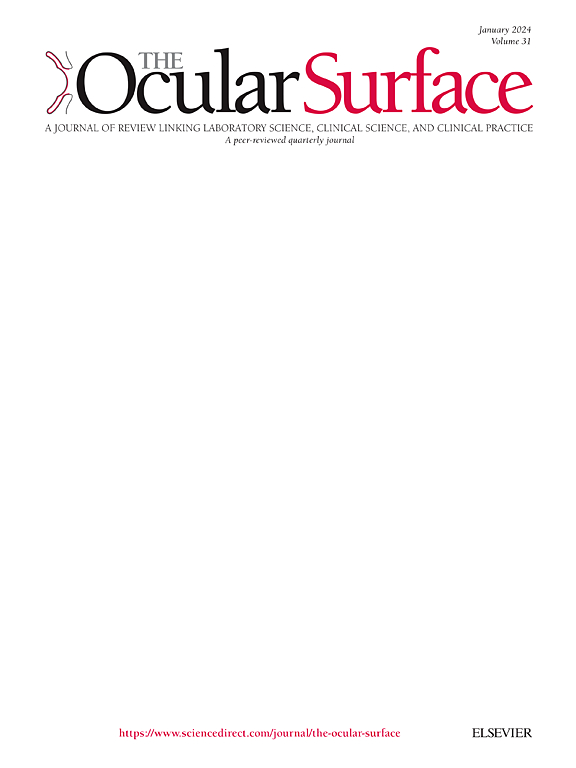Fenofibrate ameliorates ocular surface inflammation in diabetic keratopathy
IF 5.6
1区 医学
Q1 OPHTHALMOLOGY
引用次数: 0
Abstract
Purpose
To investigate the efficacy of oral fenofibrate in the amelioration of ocular surface inflammation in diabetes mellitus (DM).
Methods
In this open-label interventional study, 41 participants with type 2 DM received oral fenofibrate for 30 days. Forty age-matched healthy controls were recruited. Ocular surface objective and subjective assessment, in-vivo confocal microscopy (IVCM) imaging and quantification for corneal dendritic cells (DCs), epithelium and neuromas were performed. Tear inflammatory markers and proteomics were analyzed with enzyme-linked immunosorbent assay (ELISA) and Data Independent Acquisition experiments before and after treatment.
Results
Oral fenofibrate treatment significantly improved tear film breakup time (p = 0.004), corneal staining evaluated with National Eye Institute-Corneal Fluorescein Staining scores (p = 0.005), and ocular surface symptoms assessed with the Ocular Surface Disease Index scores (p = 0.003), in DM patients. On IVCM, fenofibrate significantly reduced mean DC area (p = 0.01) and mean DC density (p = 0.02), while increasing mean DC elongation (p = 0.004) and length (p = 0.01), suggesting less DC activities. Fenofibrate also significantly increased corneal epithelial cell density (p = 0.04). 192 tear proteins were significantly altered after treatment. Fenofibrate significantly up-regulated the expression of anti-inflammatory interleukin-1 receptor antagonist, while significantly reduced the concentrations of pro-inflammatory and inflammatory proteins, including tumour necrosis factor α, nuclear factor kappa B, complement 4 B, cytochrome B5 Type A, and cytochrome B5 Type B (all p < 0.05) in tears, via regulation of tricarboxylic acid cycle, oxidative phosphorylation and liver X receptor/retinoid X receptor activation.
Conclusion
This first clinical trial demonstrated that oral fenofibrate ameliorates diabetic ocular surface inflammation, providing a novel therapeutic option for diabetic keratopathy.
非诺贝特改善糖尿病性角膜病变的眼表炎症
目的观察非诺贝特口服治疗糖尿病(DM)眼表炎症的疗效。方法在这项开放标签的干预性研究中,41名2型糖尿病患者口服非诺贝特30天。招募了40名年龄匹配的健康对照。进行眼表客观和主观评价,角膜树突状细胞(dc)、上皮和神经瘤的体内共聚焦显微镜(IVCM)成像和定量。采用酶联免疫吸附试验(ELISA)和数据独立采集实验分析治疗前后泪液炎症标志物和蛋白质组学。结果非诺贝特治疗可显著改善糖尿病患者泪膜破裂时间(p = 0.004)、美国国家眼科研究所角膜荧光素染色评分评估角膜染色(p = 0.005)和眼表疾病指数评分评估眼表症状(p = 0.003)。在IVCM上,非诺贝特显著降低了平均DC面积(p = 0.01)和平均DC密度(p = 0.02),增加了平均DC伸长(p = 0.004)和长度(p = 0.01),表明DC活性降低。非诺贝特还显著增加了角膜上皮细胞密度(p = 0.04)。192个泪液蛋白在治疗后显著改变。非诺贝特显著上调抗炎白介素-1受体拮抗剂的表达,同时显著降低促炎和炎症蛋白的浓度,包括肿瘤坏死因子α、核因子κ B、补体4b、细胞色素B5 A型和细胞色素B5 B型(均p <;0.05),通过调节三羧酸循环、氧化磷酸化和肝脏X受体/类视黄醇X受体激活。结论首次临床试验表明,口服非诺贝特可改善糖尿病性眼表炎症,为糖尿病性角膜病变提供了一种新的治疗选择。
本文章由计算机程序翻译,如有差异,请以英文原文为准。
求助全文
约1分钟内获得全文
求助全文
来源期刊

Ocular Surface
医学-眼科学
CiteScore
11.60
自引率
14.10%
发文量
97
审稿时长
39 days
期刊介绍:
The Ocular Surface, a quarterly, a peer-reviewed journal, is an authoritative resource that integrates and interprets major findings in diverse fields related to the ocular surface, including ophthalmology, optometry, genetics, molecular biology, pharmacology, immunology, infectious disease, and epidemiology. Its critical review articles cover the most current knowledge on medical and surgical management of ocular surface pathology, new understandings of ocular surface physiology, the meaning of recent discoveries on how the ocular surface responds to injury and disease, and updates on drug and device development. The journal also publishes select original research reports and articles describing cutting-edge techniques and technology in the field.
Benefits to authors
We also provide many author benefits, such as free PDFs, a liberal copyright policy, special discounts on Elsevier publications and much more. Please click here for more information on our author services.
Please see our Guide for Authors for information on article submission. If you require any further information or help, please visit our Support Center
 求助内容:
求助内容: 应助结果提醒方式:
应助结果提醒方式:


